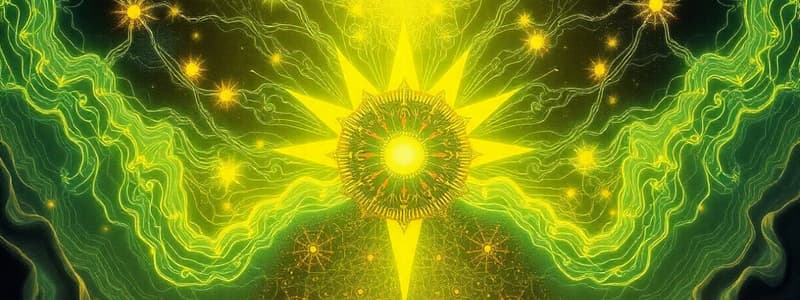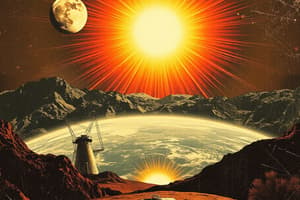Podcast
Questions and Answers
The potential difference between two points in a circuit, measured in volts, is called ______
The potential difference between two points in a circuit, measured in volts, is called ______
Voltage
A device that increases or decreases the voltage of an alternating current is called a ______
A device that increases or decreases the voltage of an alternating current is called a ______
Transformer
A circuit in which all parts are connected in a single loop is called a ______
A circuit in which all parts are connected in a single loop is called a ______
Series circuit
A circuit in which different parts are on separate branches is called a ______
A circuit in which different parts are on separate branches is called a ______
A device that converts mechanical energy into electrical energy is called a ______
A device that converts mechanical energy into electrical energy is called a ______
A magnet created by passing an electric current through a coil of wire is called an ______
A magnet created by passing an electric current through a coil of wire is called an ______
The interaction between electricity and magnetism is called ______
The interaction between electricity and magnetism is called ______
What is the difference between nuclear fission and nuclear fusion?
What is the difference between nuclear fission and nuclear fusion?
How does a nuclear power plant control a chain reaction?
How does a nuclear power plant control a chain reaction?
Why do electric field lines never cross?
Why do electric field lines never cross?
How do conductors and insulators differ?
How do conductors and insulators differ?
What causes lightning?
What causes lightning?
How does increasing resistance affect an electric circuit?
How does increasing resistance affect an electric circuit?
What is the function of a transformer in an electrical system?
What is the function of a transformer in an electrical system?
How does a parallel circuit differ from a series circuit?
How does a parallel circuit differ from a series circuit?
What role do electromagnets play in electric motors?
What role do electromagnets play in electric motors?
Why is AC used in power transmission instead of DC?
Why is AC used in power transmission instead of DC?
A wave is any disturbance that transmits ______ through matter or space.
A wave is any disturbance that transmits ______ through matter or space.
The material through which a wave travels is called a ______
The material through which a wave travels is called a ______
A wave that requires a medium to travel is called what type of wave?
A wave that requires a medium to travel is called what type of wave?
Electromagnetic waves do not require what to travel?
Electromagnetic waves do not require what to travel?
Waves that move the particles of the medium perpendicular to the direction the wave is traveling are called ______ waves.
Waves that move the particles of the medium perpendicular to the direction the wave is traveling are called ______ waves.
The highest point of a transverse wave is called the ______
The highest point of a transverse wave is called the ______
A wave in which particles move parallel to the direction of the wave is called a ______ wave.
A wave in which particles move parallel to the direction of the wave is called a ______ wave.
The areas where particles are close together in a longitudinal wave are called ______
The areas where particles are close together in a longitudinal wave are called ______
The areas where particles are spread apart in a longitudinal wave are called ______
The areas where particles are spread apart in a longitudinal wave are called ______
The number of waves that pass a given point in a certain amount of time is called ______
The number of waves that pass a given point in a certain amount of time is called ______
The distance between two corresponding parts of a wave is called ______
The distance between two corresponding parts of a wave is called ______
The maximum distance that the particles of a medium move from their rest position is called ______
The maximum distance that the particles of a medium move from their rest position is called ______
The bouncing back of a wave when it hits a surface it cannot pass through is called ______
The bouncing back of a wave when it hits a surface it cannot pass through is called ______
The bending of waves due to a change in speed as they move from one medium to another is called ______
The bending of waves due to a change in speed as they move from one medium to another is called ______
The bending of waves around the edge of a barrier is called ______
The bending of waves around the edge of a barrier is called ______
When two waves meet and combine to form a wave of greater amplitude, this is called ______ interference.
When two waves meet and combine to form a wave of greater amplitude, this is called ______ interference.
A frequency shift that occurs when a sound source moves relative to a listener is called the ______
A frequency shift that occurs when a sound source moves relative to a listener is called the ______
A loud sound heard when an object travels faster than the speed of sound is called a ______
A loud sound heard when an object travels faster than the speed of sound is called a ______
What happens to the speed of sound as the temperature of the medium increases?
What happens to the speed of sound as the temperature of the medium increases?
Flashcards
Voltage
Voltage
Potential difference between two points; measured in volts.
Transformer
Transformer
Device that increases or decreases AC voltage.
Series Circuit
Series Circuit
Circuit with all components in a single path.
Parallel Circuit
Parallel Circuit
Signup and view all the flashcards
Electric Generator
Electric Generator
Signup and view all the flashcards
Electromagnet
Electromagnet
Signup and view all the flashcards
Electromagnetism
Electromagnetism
Signup and view all the flashcards
Nuclear Fission
Nuclear Fission
Signup and view all the flashcards
Nuclear Fusion
Nuclear Fusion
Signup and view all the flashcards
Control Rods (Nuclear)
Control Rods (Nuclear)
Signup and view all the flashcards
Unique Field Direction
Unique Field Direction
Signup and view all the flashcards
Conductors
Conductors
Signup and view all the flashcards
Insulators
Insulators
Signup and view all the flashcards
Lightning
Lightning
Signup and view all the flashcards
Effect of Increasing Resistance
Effect of Increasing Resistance
Signup and view all the flashcards
Transformer Function
Transformer Function
Signup and view all the flashcards
Parallel Circuit Characteristic
Parallel Circuit Characteristic
Signup and view all the flashcards
Series Circuit Characteristic
Series Circuit Characteristic
Signup and view all the flashcards
Electromagnets in Motors
Electromagnets in Motors
Signup and view all the flashcards
Why AC for Power Transmission
Why AC for Power Transmission
Signup and view all the flashcards
Wave
Wave
Signup and view all the flashcards
Medium
Medium
Signup and view all the flashcards
Mechanical Wave
Mechanical Wave
Signup and view all the flashcards
Electromagnetic Waves Don't Need This
Electromagnetic Waves Don't Need This
Signup and view all the flashcards
Transverse Wave
Transverse Wave
Signup and view all the flashcards
Crest (Wave)
Crest (Wave)
Signup and view all the flashcards
Trough (Wave)
Trough (Wave)
Signup and view all the flashcards
Longitudinal Wave
Longitudinal Wave
Signup and view all the flashcards
Compressions (Wave)
Compressions (Wave)
Signup and view all the flashcards
Rarefactions (Wave)
Rarefactions (Wave)
Signup and view all the flashcards
Study Notes
- Voltage is the potential difference between two points in a circuit, measured in volts
- A transformer increases or decreases the voltage of an alternating current
- A series circuit connects all parts in a single loop
- A parallel circuit has parts on separate branches
- An electric generator converts mechanical energy into electrical energy
- An electromagnet is created by passing an electric current through a coil of wire
- Electromagnetism is the interaction between electricity and magnetism
- Nuclear fission splits a large nucleus into smaller ones
- Nuclear fusion combines small nuclei into a larger one
- Nuclear power plants use control rods that absorb excess neutrons to control a chain reaction and regulate the reaction
- Electric field lines never cross because each point in space has only one direction
- Conductors allow electric charges to move freely
- Insulators resist the movement of charges
- Lightning is an electric discharge from the buildup and sudden movement of electric charge in clouds
- Higher resistance reduces the flow of electric current in an electric circuit
- Transformers change the voltage of alternating current
- Parallel circuits provide multiple paths for current
- Series circuits have only one path
- Electromagnets in electric motors create a magnetic field to interact with a permanent magnet for motion
- Alternating current (AC) is used in power transmission because it can be easily transformed to higher or lower voltages for efficient power transmission
- A wave transmits energy through matter or space
- A medium is the material through which a wave travels
- Mechanical waves require a medium
- Electromagnetic waves do not require a medium
- Transverse waves move the particles of the medium perpendicular to the direction of the wave
- The crest is the highest point of a transverse wave
- The trough is the lowest point of a transverse wave
- Longitudinal waves move particles parallel to the direction of the wave
- Compressions are the areas where particles squeeze together in a longitudinal wave
- Rarefactions are the areas where particles spread apart in a longitudinal wave
- Frequency measures the number of waves passing a point in a certain amount of time
- Wavelength is the distance between two corresponding parts of a wave
- Amplitude is the maximum distance that the particles of a medium move from their rest position
- Reflection occurs when a wave bounces back from a surface it cannot pass through
- Refraction occurs when waves bend due to a change in speed when moving from one medium to another
- Diffraction occurs when waves bend around the edge of a barrier
- Constructive interference occurs when waves combine to form a wave of greater amplitude
- Destructive interference occurs when waves combine to form a wave of smaller amplitude
- Doppler Effect: A frequency shift occurs when a sound source moves relative to a listener
- Sonic Boom: A loud sound heard when an object travels faster than the speed of sound
- Increased temperature increases the speed of sound because particles move faster and transfer energy more quickly
Studying That Suits You
Use AI to generate personalized quizzes and flashcards to suit your learning preferences.




